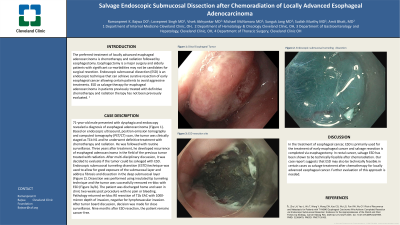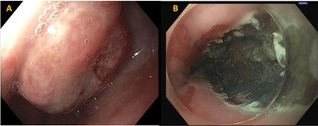Sunday Poster Session
Category: Interventional Endoscopy
P0891 - Salvage Endoscopic Submucosal Dissection After Chemoradiation of Locally Advanced Esophageal Adenocarcinoma
Sunday, October 22, 2023
3:30 PM - 7:00 PM PT
Location: Exhibit Hall

Has Audio
- RB
Ramanpreet Bajwa, DO
Cleveland Clinic Foundation
Shaker Heights, Ohio
Presenting Author(s)
Ramanpreet Bajwa, DO1, Lovepreet Singh, MD2, Vivek Abhyankar, MD2, Michael McNamara, MD2, Sunguk Jang, MD2, Sudish Murthy, MD2, Siva Raja, MD2, Amit Bhatt, MD3
1Cleveland Clinic Foundation, Shaker Heights, OH; 2Cleveland Clinic Foundation, Cleveland, OH; 3Cleveland Clinic, Cleveland, OH
Introduction: The preferred treatment of locally advanced esophageal adenocarcinoma is chemotherapy and radiation followed by esophagectomy. Esophagectomy is a major surgery and elderly patients with significant co-morbidities may not be candidates for surgical resection. Endoscopic submucosal dissection (ESD) is an endoscopic technique that can achieve curative resection of early esophageal cancer allowing certain patients to avoid aggressive treatments. ESD as salvage therapy for esophageal adenocarcinoma in patients previously treated with definitive chemotherapy and radiation therapy has not been previously evaluated.
Case Description/Methods: A 71-year-old male presented with dysphagia and endoscopy revealed a diagnosis of esophageal adenocarcinoma (Figure 1). Based on endoscopic ultrasound, positron emission tomography and computed tomography (PET/CT) scan, the tumor was clinically staged as T1b N1 and he underwent definitive treatment with chemotherapy and radiation. He was followed with routine surveillance. Three years after treatment, he developed recurrence of esophageal adenocarcinoma in the field of the previous tumor treated with radiation. After multi-disciplinary discussion, it was decided to evaluate if the tumor could be salvaged with ESD. Endoscopic submucosal tunneling dissection (ESTD) technique was used to allow for good exposure of the submucosal layer and address fibrosis and dissection in the deep submucosal layer. Dissection was performed using insulated tip tunneling technique and the tumor was successfully removed en-bloc with ESD (Figure 1). The patient was discharged home and seen in clinic two weeks post procedure with no pain or bleeding. Pathology returned en-bloc R0 resection of T1b EAC with 1000-micron depth of invasion, negative for lymphovascular invasion. After tumor board discussion, decision was made for close surveillance. Nine months after ESD resection, the patient remains cancer free.
Discussion: In the treatment of esophageal cancer, ESD is primarily used for the treatment of early esophageal cancer and salvage resection is completed via esophagectomy. In rectal cancer, salvage ESD has been shown to be technically feasible after chemoradiation. Our case report suggests that ESD may also be technically feasible in certain cases as salvage treatment after chemotherapy for locally advanced esophageal cancer. Further evaluation of this approach is needed.

Disclosures:
Ramanpreet Bajwa, DO1, Lovepreet Singh, MD2, Vivek Abhyankar, MD2, Michael McNamara, MD2, Sunguk Jang, MD2, Sudish Murthy, MD2, Siva Raja, MD2, Amit Bhatt, MD3. P0891 - Salvage Endoscopic Submucosal Dissection After Chemoradiation of Locally Advanced Esophageal Adenocarcinoma, ACG 2023 Annual Scientific Meeting Abstracts. Vancouver, BC, Canada: American College of Gastroenterology.
1Cleveland Clinic Foundation, Shaker Heights, OH; 2Cleveland Clinic Foundation, Cleveland, OH; 3Cleveland Clinic, Cleveland, OH
Introduction: The preferred treatment of locally advanced esophageal adenocarcinoma is chemotherapy and radiation followed by esophagectomy. Esophagectomy is a major surgery and elderly patients with significant co-morbidities may not be candidates for surgical resection. Endoscopic submucosal dissection (ESD) is an endoscopic technique that can achieve curative resection of early esophageal cancer allowing certain patients to avoid aggressive treatments. ESD as salvage therapy for esophageal adenocarcinoma in patients previously treated with definitive chemotherapy and radiation therapy has not been previously evaluated.
Case Description/Methods: A 71-year-old male presented with dysphagia and endoscopy revealed a diagnosis of esophageal adenocarcinoma (Figure 1). Based on endoscopic ultrasound, positron emission tomography and computed tomography (PET/CT) scan, the tumor was clinically staged as T1b N1 and he underwent definitive treatment with chemotherapy and radiation. He was followed with routine surveillance. Three years after treatment, he developed recurrence of esophageal adenocarcinoma in the field of the previous tumor treated with radiation. After multi-disciplinary discussion, it was decided to evaluate if the tumor could be salvaged with ESD. Endoscopic submucosal tunneling dissection (ESTD) technique was used to allow for good exposure of the submucosal layer and address fibrosis and dissection in the deep submucosal layer. Dissection was performed using insulated tip tunneling technique and the tumor was successfully removed en-bloc with ESD (Figure 1). The patient was discharged home and seen in clinic two weeks post procedure with no pain or bleeding. Pathology returned en-bloc R0 resection of T1b EAC with 1000-micron depth of invasion, negative for lymphovascular invasion. After tumor board discussion, decision was made for close surveillance. Nine months after ESD resection, the patient remains cancer free.
Discussion: In the treatment of esophageal cancer, ESD is primarily used for the treatment of early esophageal cancer and salvage resection is completed via esophagectomy. In rectal cancer, salvage ESD has been shown to be technically feasible after chemoradiation. Our case report suggests that ESD may also be technically feasible in certain cases as salvage treatment after chemotherapy for locally advanced esophageal cancer. Further evaluation of this approach is needed.

Figure: Figure 1. Distal Esophageal Tumor Prior to ESD Resection (A) and Post-ESD Resection Site (B)
Disclosures:
Ramanpreet Bajwa indicated no relevant financial relationships.
Lovepreet Singh indicated no relevant financial relationships.
Vivek Abhyankar indicated no relevant financial relationships.
Michael McNamara indicated no relevant financial relationships.
Sunguk Jang indicated no relevant financial relationships.
Sudish Murthy indicated no relevant financial relationships.
Siva Raja indicated no relevant financial relationships.
Amit Bhatt: Boston Scientific – Consultant. Medtronic – Consultant, Intellectual Property/Patents. Steris – Consultant.
Ramanpreet Bajwa, DO1, Lovepreet Singh, MD2, Vivek Abhyankar, MD2, Michael McNamara, MD2, Sunguk Jang, MD2, Sudish Murthy, MD2, Siva Raja, MD2, Amit Bhatt, MD3. P0891 - Salvage Endoscopic Submucosal Dissection After Chemoradiation of Locally Advanced Esophageal Adenocarcinoma, ACG 2023 Annual Scientific Meeting Abstracts. Vancouver, BC, Canada: American College of Gastroenterology.
